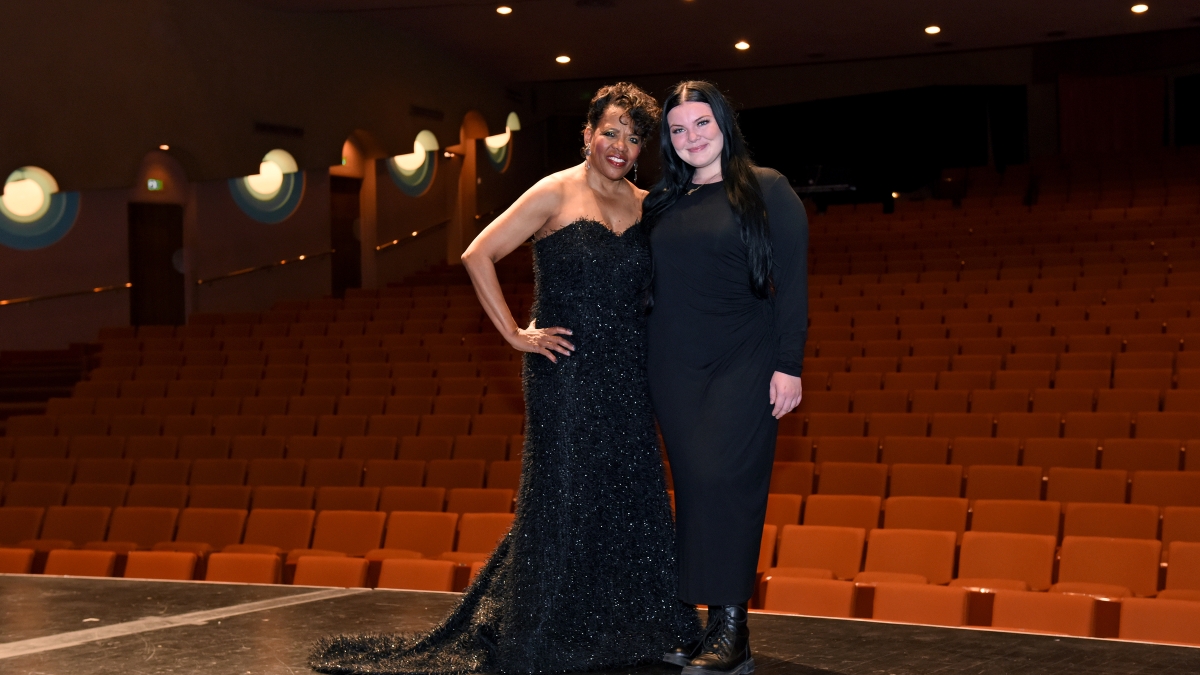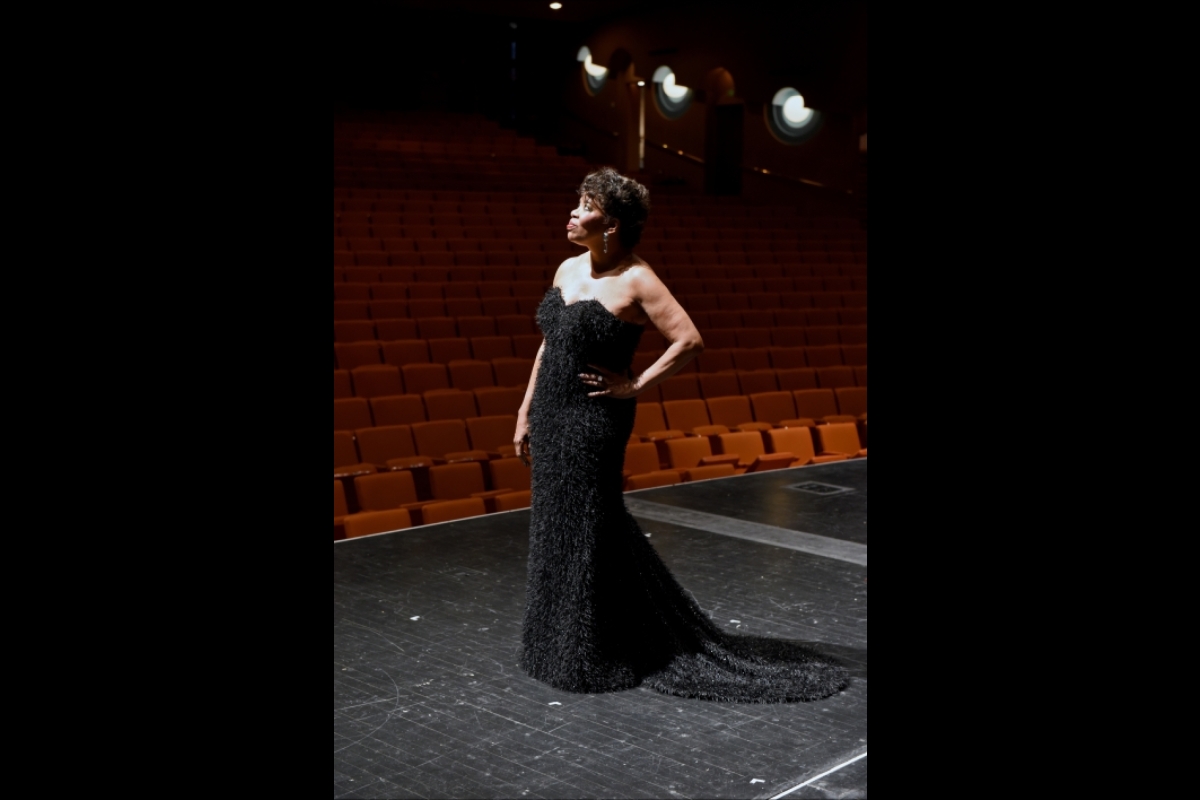ASU alumna designs red carpet gown for Tony Awards

Colleen Jennings-Roggensack (left) wearing the gown designed by Abigail Davis. Photo courtesy ASU Gammage
Arizona State University alumna Abigail Davis has always had her heart set on the world of fashion.
First learning to sew at age 5, Davis is ambitious and dedicated in her design ventures, which range from her senior capstone collection to her debut couture business.
Now, at age 23, Davis has completed her biggest venture yet: a unique designer gown to be worn at the 76th Tony Awards red carpet and ceremony set for June 11 in New York City.
Colleen Jennings-Roggensack, the executive director of ASU Gammage and ASU’s vice president for cultural affairs, is the sole voter to represent Arizona for the Tony Awards and will be wearing Davis’ creation on Broadway’s biggest night. Jennings-Roggensack sought Davis out following her tradition of enlisting Arizona-based designers for the event and was quickly acquainted with her in the process.
“Abigail is magic. Absolutely magic,” Jennings-Roggensack said. “She figured out how to outshine the stars I’ll be there with. I'm always so proud to say there is tremendous talent in Arizona.”
Davis graduated from ASU’s fashion program in 2022, before forming her company, PHENOM Couture, with her senior capstone fashion collection. Her brand aims to create custom couture fashion that exudes the personality of her clients and blends with her playfully elegant aesthetic. Above all, Davis emphasizes inclusivity of each body in every way possible.
“PHENOM believes at its core that everyone is phenomenal and deserves to be celebrated and accelerated,” Davis said. “It's all about reaching their ultimate potential through fashion, because ultimately the best dress is a great smile.”
Creating a gown this intricate, unique and thoughtful is a feat within itself — five months of work went into the process. Fashion design takes just as many technical skills as it does creative energy, but Davis has already mastered these abilities at ASU.
After graduating from high school in 2017, Davis decided against out-of-state fashion school due to cost – but ASU's fashion program started that same year. Davis to chalk it up to divine timing.
“If ASU fashion didn't create their program when it did, I wouldn't have even been able to go to college,” Davis said. “It's been such a crazy experience to see the program grow so much, to move into the ASU Downtown (Phoenix) campus, and all the incredible things they're doing with this new technology. I'm very proud to be from Arizona and be affiliated with ASU.”
Davis is thankful for ASU’s innovative nature. Her exposure to cutting-edge fashion technology during her time as a student introduced her to the new age of sustainable couture.
“ASU is the exclusive place where you can learn how to use the newest software, like Opex. It creates an extremely sustainable and rapid process of pattern making, and it's so much more accurate to the person or body that you're trying to dress,” Davis explained. “Learning it provides such an edge in this industry, so it’s incredible that ASU can even offer that at a public university. You wouldn't even find that at some of the top fashion schools in New York City.”
From the classroom to the creation of PHENOM, sustainability has remained an area of focus for Davis’ designs, in more ways than one. From the fabrics that she uses to the structure of the clothing itself, PHENOM designs aim for longevity and purpose in the closets of its clients.
“Sustainability takes form through several different factors for us here. Every project gets repurposed as filling for making coats — we're repurposing every single scrap that we produce,” Davis said. “As far as sustainability goes with our couture services, I'm a pattern maker originally, so there's sustainability within the integrity of our designs as well. Our gowns will grow with you and will be able to be passed on generationally because it’s not made out of a fixed material.”
Jennings-Roggensack’s gown puts Davis’ words to life, as the unique 3D lace fabric was hand sourced by Davis in 2020 and used to its entirety, meaning that no other dress can be made with this now archived material. Additionally, the spandex-based materials found in the corset expands up to three sizes, allowing the design to breathe with the person wearing it.
“Abigail has an incredible contemporary eye,” Jennings-Roggensack said. “When I wear this gown, I will be channeling two things: a very talented designer who happens to be a graduate of ASU and the state of Arizona. People will be shouting, 'Who designed your dress?' Abigail Davis did.”
When given the role of representing Arizona at one of the biggest awards events of the year through fashion, Davis set herself and the brand aside to focus on celebrating Jennings-Roggensack at every level she possibly could and sharing this Southwestern vision with the world.
“Through our entire process together and how we came up with the final design, it is such a co-creation. Colleen is extremely inspiring, playful and such a force of nature,” Davis said. “This is the biggest opportunity I've had in my career thus far, and I truly could not be more honored to have Colleen wearing it.”
More Arts, humanities and education

ASU+GSV Summit brings experts together to discuss advancements in education
Arizona State University President Michael Crow kicked off the ASU+GSV education technology summit in San Diego on Monday with a…

ASU professor's project helps students learn complex topics
One of Arizona State University’s top professors is using her signature research project to improve how college students learn…

Award-winning playwright shares her scriptwriting process with ASU students
Actions speak louder than words. That’s why award-winning playwright Y York is workshopping her latest play, "Becoming…





